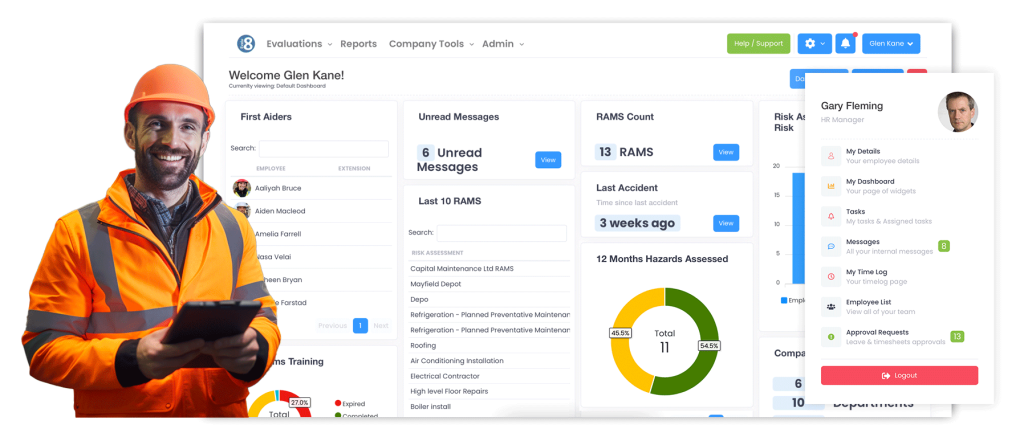COSHH, which stands for Control of Substances Hazardous to Health, is a set of regulations that aim to protect workers from health risks associated with hazardous substances in the workplace. It is a legal requirement for employers to adhere to these regulations and ensure the safety and well-being of their employees. In this comprehensive overview, we will delve into the definition and history of COSHH, explore its importance in the workplace, examine the components of a COSHH assessment, discuss the roles of employees and employers in implementing COSHH, and look at real-life case studies that highlight the successes and failures of COSHH.
Understanding COSHH: A Comprehensive Overview
COSHH is a regulatory framework that focuses on ensuring the safe use, storage, handling, and disposal of hazardous substances in the workplace. These substances can include chemicals, fumes, dust, mists, vapors, gases, and biological agents. The primary goal of COSHH is to prevent or control exposure to such substances and minimize the risks they pose to workers’ health.
Definition of COSHH
COSHH regulations, established under the Health and Safety at Work Act 1974, require employers to assess and control the risks associated with hazardous substances in their workplace. The regulations aim to protect employees from a wide range of health problems, including respiratory diseases, dermatitis, cancer, and long-term damage to internal organs.
The History and Evolution of COSHH
The origins of COSHH can be traced back to the mid-1970s when the UK government recognized the need for specific regulations to address the health hazards posed by hazardous substances. Over the years, COSHH has evolved to reflect advancements in scientific knowledge, technological innovations, and changes in the nature of work. The regulations are regularly updated to stay in line with current best practices and the changing landscape of industries.
As the understanding of the potential risks associated with hazardous substances has increased, so too has the need for comprehensive regulations like COSHH. In the early days, there was limited awareness of the long-term health effects of exposure to certain substances. However, with the advancement of scientific research and the accumulation of evidence, it became evident that stronger measures were necessary to protect workers.
COSHH has not only played a crucial role in safeguarding the health and well-being of employees but has also contributed to the overall improvement of workplace safety standards. The regulations have prompted employers to invest in better control measures, such as ventilation systems, personal protective equipment, and safe handling procedures.
Throughout its history, COSHH has adapted to the changing needs and challenges of different industries. As new substances and technologies emerge, the regulations are updated to address these developments. For example, in recent years, there has been a growing focus on the potential health risks associated with nanomaterials. As a result, COSHH has expanded its scope to include guidelines and control measures specific to this emerging field.
Furthermore, COSHH has not only influenced national legislation but has also served as a model for other countries seeking to establish their own frameworks for managing hazardous substances. Many countries around the world have looked to the UK’s approach to COSHH as a benchmark for developing their own regulations, adapting them to suit their unique circumstances.
As we move forward, the evolution of COSHH will continue to be driven by ongoing research, technological advancements, and the changing nature of work. The aim will always be to ensure that workers are protected from the potential health risks posed by hazardous substances, enabling them to work in a safe and healthy environment.
The Importance of COSHH in the Workplace
Ensuring Employee Safety
The central importance of COSHH (Control of Substances Hazardous to Health) lies in safeguarding the health and well-being of workers. By implementing COSHH regulations, employers demonstrate their commitment to protecting their employees from harm and minimizing their exposure to hazardous substances. This not only reduces the risk of immediate health problems but also helps prevent long-term health issues.
One of the key aspects of COSHH is the identification and assessment of hazardous substances in the workplace. This involves understanding the potential risks associated with different substances, such as chemicals, dust, and fumes, and taking appropriate measures to control and manage these risks. By doing so, employers create a safe working environment where employees can carry out their tasks without fear of harm.
Furthermore, COSHH emphasizes the importance of providing adequate training and information to employees regarding the potential hazards they may encounter in their work. This empowers workers to take necessary precautions and use protective equipment effectively, reducing the likelihood of accidents or injuries.
Legal Implications and Compliance
COSHH compliance is not just a matter of best practice; it is a legal requirement for all employers. Failure to meet the regulations can result in severe penalties, including fines and prosecution. By adhering to COSHH, employers can fulfill their legal obligations and avoid the potential legal consequences associated with non-compliance.
Complying with COSHH involves several key steps. Firstly, employers must conduct a thorough assessment of the substances used or produced in their workplace. This assessment should identify any potential hazards and evaluate the level of risk they pose to employees. Based on the assessment, appropriate control measures should be implemented to minimize the risk, such as substituting hazardous substances with safer alternatives, implementing engineering controls, and providing personal protective equipment.
Regular monitoring and review of control measures are also essential to ensure their effectiveness and make necessary adjustments if required. This includes monitoring exposure levels, conducting health surveillance, and providing ongoing training and information to employees.
In addition to protecting employees, COSHH compliance also helps to maintain a positive reputation for the organization. Demonstrating a commitment to employee safety and well-being can enhance the company’s image and attract and retain talented individuals who prioritize a safe working environment.
In conclusion, the importance of COSHH in the workplace cannot be overstated. By prioritizing employee safety, complying with regulations, and implementing effective control measures, employers can create a safe and healthy work environment that not only protects their employees but also ensures legal compliance and fosters a positive organizational reputation.
Components of a COSHH Assessment
Identifying Hazardous Substances
A fundamental aspect of COSHH is recognizing and identifying the hazardous substances present in the workplace. This involves conducting a thorough inventory of chemicals, materials, and processes that have the potential to harm workers’ health.
During the process of identifying hazardous substances, it is crucial to consider the various forms in which they can exist. Substances can be in solid, liquid, or gas form, each with its own unique properties and potential risks. For example, a solid substance may pose a risk of inhalation if it can be easily dispersed into the air as fine particles.
In addition to considering the physical form of the substances, it is important to take into account their chemical properties. Some substances may be highly reactive and can cause explosions or fires when they come into contact with certain materials or conditions. Others may be corrosive, causing damage to skin or other materials upon contact.
Evaluating Risks and Implementing Control Measures
Once the hazardous substances have been identified, employers must assess the risks associated with their use. This involves evaluating the likelihood and severity of potential harm. The evaluation process takes into consideration various factors, such as the concentration and duration of exposure, as well as any existing control measures in place.
During the risk evaluation, it is important to consider the different routes of exposure that workers may face. Substances can enter the body through inhalation, ingestion, or skin contact, and each route may present different risks. For example, a substance that is harmful when inhaled may not pose the same level of risk if it is only present in a solid form that does not easily become airborne.
Based on the assessment of risks, control measures must be implemented to minimize or eliminate the risks. These measures can include substitution, engineering controls, administrative controls, and personal protective equipment (PPE).
Substitution involves replacing hazardous substances with less harmful alternatives. For example, using water-based paints instead of solvent-based paints can reduce the risk of exposure to harmful fumes.
Engineering controls focus on modifying the workplace or processes to reduce exposure to hazardous substances. This can include the installation of ventilation systems to remove airborne contaminants or the use of enclosed systems to prevent direct contact with hazardous materials.
Administrative controls involve implementing policies and procedures to minimize exposure. This can include measures such as limiting the time spent working with hazardous substances, providing training and education on safe handling practices, and implementing regular monitoring and maintenance of control measures.
Personal protective equipment (PPE) is the last line of defense and should only be relied upon when other control measures are not sufficient. PPE includes items such as gloves, masks, goggles, and protective clothing. It is important to ensure that the correct type of PPE is used for the specific hazards present and that it is properly maintained and used correctly.
By evaluating risks and implementing appropriate control measures, employers can effectively protect the health and safety of their workers when dealing with hazardous substances.
The Role of Employees and Employers in COSHH
Responsibilities of Employers
Under COSHH regulations, employers have a duty of care towards their employees. Employers are responsible for ensuring that hazardous substances are properly controlled, risks are assessed and managed, and appropriate training is provided. Employers must also maintain accurate records, provide relevant information and guidance, and regularly review and update their COSHH assessments.
Responsibilities of Employees
Employees also have a role to play in ensuring the effectiveness of COSHH in the workplace. They have a duty to follow safe working practices, use PPE as instructed, cooperate with the employer’s control measures, and report any concerns or incidents promptly. Employees should actively participate in COSHH training and raise awareness of potential hazards.
While COSHH regulations are designed to prevent incidents and safeguard health, there have been instances where failures in compliance have led to tragic consequences. For instance, inadequate control measures and failure to properly assess risks can result in chemical spills or exposure, causing severe injuries or even fatalities. Examining such failures allows us to learn from past mistakes and emphasize the importance of strict adherence to COSHH regulations.
In conclusion, COSHH plays a crucial role in protecting workers’ health and preventing harm caused by hazardous substances in the workplace. Understanding the definition, history, and various components of COSHH is vital for employers and employees alike. By fulfilling their responsibilities, implementing effective control measures, and learning from both successful implementations and failures, organizations can create safer working environments and prioritize the well-being of their workforce.
Watch Our 4-Minute Video
Fill in the form to see a better EHS management system.
“It has brought all of our health and safety under one roof and made it easy for me to see all the data”




